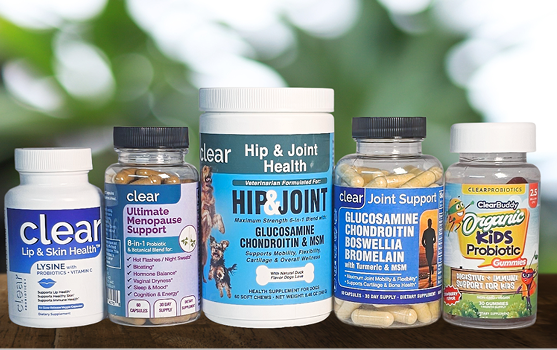Joint Pain Causes and Support
What causes joint pain and how do you treat it?
Do you feel soreness or tightness in any part of your body that bends?
Do you feel tinges of pain when you move your fingers, wrists, elbows, shoulders, hips, or ankles a certain way? Is knee pain a constant in your daily life?
If so, you might be suffering from joint pain. We’re going to discuss joint pain and how you can help it feel better by reducing the inflammation in your body.
What is joint pain?
Joint pain is defined as discomfort where two or more bones meet to form a joint. Joint pain most commonly occurs in the hands, knees, feet, hips, or spine but can also occur in the fingers, wrists, ankles, shoulders, and more. [1]
Joint pain symptoms include pain that may stop and start, such as when you make certain movements. It could be constant. The types of pain differ, from throbbing or tightness to aches or even burning. Some patients report a grinding sensation.
Sometimes the joint may hurt when you move it. Other times it hurts when it’s stiff. Still, others hurt when you move them too much.
No matter what kind of joint pain you have, the root cause comes from some type of inflammation.
What causes joint pain?
Although sometimes unexplained joint pain can occur, most types of joint pain happen due to half a dozen conditions, all of which have a base cause of inflammation in your body. Inflammatory diseases are also a cause of joint pain. Many of these common causes of joint pain can be categorized as rheumatic diseases.
Rheumatoid Arthritis
Joint pain from rheumatoid arthritis causes swelling in the fingers or wrists due to deformed joints, or acute inflammation. This type of joint pain is visible when someone’s fingers look bent or misshapen.
Osteoarthritis
One of the most common types of joint pain, osteoarthritis, happens most often in middle-aged people because this condition develops slowly over time. When cartilage, or soft tissues like those found in your ears and nose, wears away over time. Osteoarthritis may occur when joints become painful and stiff due to more bone coming in contact with each other.
Gout
Gout normally occurs in the big toe, and it’s very painful. Tiny crystals that form in your body collect in the big toe while causing severe pain and swelling.
Bursitis
Overusing a particular joint in your body may cause the bursa, or a fluid-filled sac in your joint, to swell. This condition is called bursitis, and it typically happens in the knee, elbow, hip, or shoulder.
Tendonitis
The tendons around a joint may become inflamed by a condition called tendonitis. These are flexible bands that connect your muscles to the bones. You may experience tendonitis in your elbow, heel, or shoulder after making too many repetitive motions over time. Baseball pitchers and tennis players typically get tendonitis due to overworking their arms.
Injuries
An injury to a joint, or a muscle sprain or broken bone can cause joint pain. Injuries that heal properly may or may not lead to chronic joint pain, depending on the severity of the injury.
Infections
Infections from a virus or bacteria could cause a rash and lead to a fever, which may make your joints painful.
An infection causes inflammation due to a natural response from your body’s immune system. Inflammation makes joint pain worse.
What is inflammation?
Inflammation is a natural response in your body when your immune system tries to attack any invaders. Your body will make more white blood cells to combat bacteria or viruses in an attempt to kill them [2].
When arthritis happens, your body’s immune system will cause inflammation and swelling when there are no viruses or bacteria to fight off. That’s why controlling inflammation can help joint pain.
Having inflammation all of the time is called chronic inflammation, and this condition may make joint pain worse.
Where can I feel joint pain?
Joint pain occurs anywhere your body makes a bending motion or has a range of motion.
Your joints include:
- Neck
- Back
- Jaw
- Shoulders
- Elbows
- Wrists
- Hips
- Knees
- Ankles
Who is more at risk for joint pain?
There are five main risk factors for joint pain, including:
Your sex. Women are more likely to develop rheumatoid arthritis compared to men. However, most of the people who have gout are men.
Age. As we age the risks for many types of arthritis, such as rheumatoid arthritis, osteoarthritis, and gout, increase significantly.
Heredity. Does someone in your family have joint pain? Some kinds of arthritis run in families. If your parents or sibling has arthritis, you may be more likely to get it.
Injury. Have you injured a joint in the past? If you hurt a joint while playing a sport or if you got into an accident, you run a greater risk of joint pain later in life.
Obesity. Carrying excess weight on a regular basis puts a lot more stress on your joints, especially the spine, hips, and knees. You will have a higher risk of developing arthritis if you suffer from obesity.
How does joint pain affect my life?
Joint pain can reduce the quality of life because it affects how you move, your physical abilities, and your mood. You could be less active, be more prone to depression, and cause your family to worry about your overall health.
Luckily, there are ways you can combat joint pain naturally.
How does inflammation make joint pain worse?
Blood vessels around your inflamed joint dilate, which allows more blood to reach the affected joint. It’s your body’s natural reaction to a body part that is injured.
White blood cells, the main focus of your body's natural immune response, invade the inflamed joint to do their work against whatever is irritating your body. Because of the extra blood near the joint, it becomes inflamed. [4]
Chronic (continuous) joint pain could come from the inflammation that ends up attacking joint tissues, which in turn causes the joint to swell, increases joint fluid, damages the cartilage (soft tissues) and bone, and eventually creates a loss of muscle due to reduced movements. [5]
Getting rid of this inflammation represents a vital key to eliminating joint pain.
How can I reduce inflammation and joint pain in my body?
Diet. An anti-inflammatory diet, such as the foods found in the Mediterranean diet, can help ease inflammation over time. Healthy choices like fatty fish, lean meats, and plenty of vegetables can give your body a natural boost. Avoid sugary foods if at all possible.
Eating the right foods can improve your gut biome, which can signal to your body to reduce systemic inflammation caused by a constant immune response. [6]
Exercise. Low-impact exercises, such as walking, swimming, and low-impact aerobics get your joints back to moving properly. Exercise also builds muscle. Make sure to stretch first and keep that connective tissue limber.
Lifestyle choices. Don’t smoke and reduce or eliminate alcohol consumption. These things make it harder to get active.
Supplements. Choosing the right supplements can foster a healthy gut biome in your intestines, improving your body’s inflammatory response and improving joint pain. Herbal supplements such as Glucosamine, Chondroitin, Turmeric, Boswellia and Bromelain have been proven to have positive anti-inflammatory effects on the body, and to build healthy cartilage to protect joints.
As with any changes in your body, consult with your primary care physician for relevant and professional advice on how to take care of your body.
Sources:
- https://my.clevelandclinic.org/health/symptoms/17752-joint-pain
- https://www.webmd.com/arthritis/about-inflammation
- https://www.mayoclinic.org/diseases-conditions/arthritis/symptoms-causes/syc-20350772
- https://www.medicalnewstoday.com/articles/joint-inflammation
- https://www.arthritis.org/health-wellness/healthy-living/managing-pain/understanding-pain/causes-of-inflammatory-joint-pain
- https://www.frontiersin.org/articles/10.3389/fmicb.2020.01065/full








